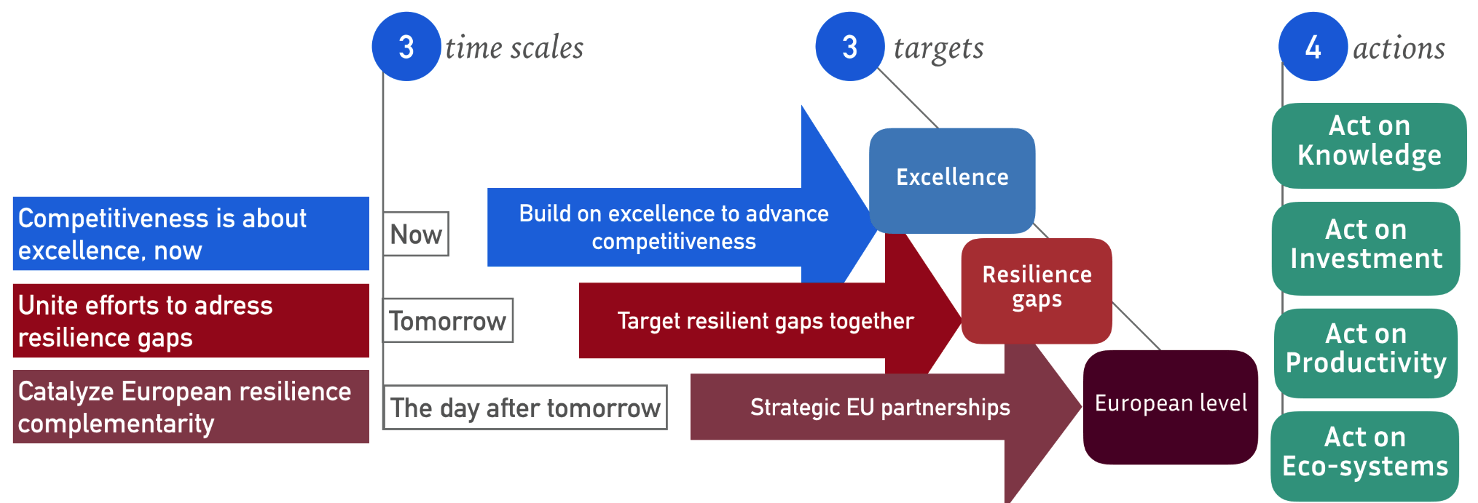
Introduction
Europe stands at a critical junction in the global digital and technological landscape, where its capacity to act decisively depends fundamentally on knowledge, investment, productivity and ecosystem development.
As geopolitical competition becomes increasingly explicit and technological dependencies deepen, Europe must move beyond reactive policymaking and build genuine technological resilience frameworks – not through isolation, but through a strategic resilience roadmap grounded in capabilities at different layers of the European technology stack, strategic European partnerships and values-aligned global engagement.
This policy brief outlines both a preliminary methodology and a phased agenda for action: immediate steps to lay the foundations for competitiveness; medium-term measures to scale interventions that transform resilience gaps into sustainable assets; and long-term structural shifts to strengthen Europe’s strategic positioning in the global digital environment.
Methodology
A structured analytical framework lies at the core of our approach and is built around three interconnected targets, each examined through specific diagnostic questions across differentiated time horizons. The methodology treats excellence, resilience gaps and European partnerships as complementary rather than competing priorities, recognising that Europe must build on areas of current excellence while addressing critical resilience gaps in the European Tech Stack in the medium and longer term.


The approach rejects binaries between competitiveness and resilience, emphasising instead their interdependence. Excellence provides the foundation for global competitiveness today; resilience ensures targeted investment and sustainability against systemic vulnerabilities tomorrow; and strategic European partnerships enable the complementarity and scale required the day after.
The temporal dimensions selected for incremental action – immediate (Now), medium term (Tomorrow) and long term (Day After) – allow for clear prioritisation while maintaining consistency across implementation phases.
The proposed roadmap begins with strategic European partnerships (“coalitions of the willing”) and expands to the broader European context, acknowledging that effective solutions must operate at both national and continental levels. This multi-level and phased methodology reflects the complexity of building technological resilience: defensive gap-filling and proactive capability-building must advance in tandem. National or bilateral initiatives can serve as early catalysts, but the ultimate objective is coordinated European cooperation that gradually develops a shared European technology base within a competitive global environment.
To guide this process, we structure the required actions into four categories: Acting on Knowledge, Acting on Investment, Acting on Productivity and Acting on Ecosystems
Act on Knowledge
Knowledge will be decisive in determining whether Europe emerges as a strategic technology builder and trend-setter, or remains a rule-taker in a rapidly shifting global landscape.
The window for action is narrow even on more long term actions. Decisions taken today on talent development, research priorities, standards and innovation mechanisms will shape Europe’s economic competitiveness for decades to come, as well as its capacity to understand, influence and defend its values in an increasingly technology-mediated world.
Recommendations in this brief outline how Europe can strengthen knowledge capabilities at multiple levels: from establishing in-house technical expertise within governments and policy units to enhance state capacity for technically grounded decision-making, to mapping critical resilience gaps, and launching ambitious ‘moonshot’ initiatives that inspire a new generation of European technological talent and youth. These measures offer a pathway to translate national excellence into European-wide competitiveness, to become strategically indispensable in key technology domains such as cloud and Frontier AI, and to target resilience gaps across the European Tech Stack.
The proposed method unfolds across three phases aimed at building Europe’s technological sovereignty through knowledge capacity.

Now
• Embed tech talent into public institutions to build in‑house policy capacity
• Strengthen tech diplomacy efforts, for example by incentivising national expert participation in standard-setting bodies and establishing a European Tech Diplomacy Unit to support values-based alignment across ISO, ETSI, IETF and GPAI.
• Create a digital public infrastructure (DPI) knowledge repository (reference code, governance).
• Promote the inclusive development of meaningful metrics to measure technological sovereignty and resilience, ensuring sufficient nuance (e.g. ‘gradients of sovereignty/resilience’).
• Develop a comprehensive ‘sovereignty mapping’, including risk assessments, scenario planning, foresight exercises and crisis testing, to identify supply-chain interdependencies (data, personnel, tech stack), critical choke points and strategic strengths.
Tomorrow
• Fund R&D into exploring new AI model architectures.
• Upskill SMEs to adopt a sovereign European Tech Stack.
• Create public-private tandem fellowships to strengthen technological understanding within the public sector.
• Launch a ‚Tech Erasmus Programme‘ across sectors and Member States to foster a shared European tech identity, improve understanding between the public and private sectors and cultivate the next generation of European tech talent and change-makers.
Day After
• Launch a flagship ‘European Moonshot’ or ‘European Dream’ initiative to attract and inspire next-generation tech talent and engage the wider public.
• Institutionalise a foresight ‘hedge radar’ to monitor strategic gaps and anticipate future technological developments (e.g. quantum, energy, raw materials, microelectronics).
Act on Investment
To establish immediate technological resilience and address critical vulnerabilities, Europe must take decisive action fronts, beginning with EU-level demand aggregation and a targeted investment strategy focused on fast-track projects and the scale-up of a robust sovereign technology fund.
Bundling public procurement across Member States can position governments as collective ‘anchor customers’ for European technology providers. This mechanism could be further strengthened through a ‘Buy European Act’ – a procurement framework that prioritises European solutions, drives innovation, rewards interoperability and measurable security performance through certified European products, and establishes coordinated, long-term investment mechanisms that support both operational excellence and closing of resilience gaps. An expanded European Sovereign Tech Fund could back critical open-source components, hardware and cybersecurity capabilities that underpin digital trustworthiness.
Building on these foundations, Europe could institutionalise longer-term mechanisms to sustain digital resilience and create enduring structures for innovation and investment in critical technologies. These efforts can be organised around three critical pillars: Institutionalising open-source funding within the EU’s broader resilience strategy. Creating funding structures that attract combined public and private investment to accelerate European innovations to market – for example, through a high-risk deep-tech capital vehicle complemented by a private fund to bridge the financing gap that currently drives promising European ventures abroad. Creating dedicated marketplaces for digital public infrastructures that can serve as catalysts for widespread adoption and innovation across Europe.

Now
• Fast‑track targeted investment in strategic projects and launch challenge-driven mechanisms (e.g. France’s Interministerial Digital Directorate, Germany’s Federal Agency for Disruptive Innovation SPRIN-D) to build minimum viable products that address operational needs and resilience gaps.
• Scale-up a European Sovereign Tech Fund to support critical open-source, hardware and cybersecurity components that underpin digital trustworthiness.
• Leverage existing sovereign cloud initiatives and national pilots to generate early demand signals for European technology solutions.
Tomorrow
• Introduce a ‚Buy European Act‘ for critical digital infrastructures and services to create critical demand.
• Establish long‑term public-private partnerships for sovereign digital public infrastructures (e.g. EU Citizen or Business Wallets) and reach mass adoption.
• Create dedicated marketplaces for digital public infrastructures.
• Pool innovation‑oriented public procurement and digital public infrastructure investments, including the development of ‚families‘ of gigafactories.
• Use AI Gigafactory funds to prioritise sovereign chip and cloud alternatives (e.g. SiPEARL, EUCLYD, Axelera, Arago, STX, Semi Dynamics).
• Shift procurement practices from compliance-based checklists to resilience-driven outcomes, using 90-day pilot-to-scale cycles.
• Advance initiatives that complete the EU single market and capital markets union.
Day After
• Institutionalise open-source funding as a core pillar of the EU’s resilience strategy.
• Set up a high‑risk EU deep‑tech capital vehicle, complemented by a private European fund, and make European stock exchanges an attractive exit route for start-ups.
Act on Productivity
Europe’s productivity challenge demands coordinated action across the entire technology stack – from frontier AI models to secure data centres, from domain-specific data verticals to edge computing and semiconductor capabilities. While global competitors concentrate resources in integrated, monolithic technology stacks, Europe’s pathway to productivity gains lies in the strategic orchestration of several levers: responsibly unlocking data trapped in silos; deploying fit-for-purpose AI solutions tailored to European needs and privacy-preserving values (e.g. small language models); building trusted infrastructure that transforms regulatory compliance from a constraint into a global competitive advantage; and deepening collaboration across universities, research laboratories and industry.
The actions proposed below focus on the key productivity drivers at each layer of the stack, recognising that advances in one domain can have multiplier effects across others. Improved data access enables more effective AI training; sector-specific models enhance industrial efficiency; and secure, privacy-preserving infrastructure provides the level of trust required for data sharing, value creation and positioning Europe as a values-driven global data-hosting region.

Now
• Establish an EU Data Access Facility and the supporting infrastructure required to unlock data for productivity, industry and health.
• Leverage small language models (SLMs) to meet Europe-specific productivity needs and deliver technologically secure and sovereign public services.
• Develop domain‑specific data clusters using verified, privacy-preserving training data.
• Adopt a ’signal economy‘ approach in Security Operations Centres by prioritising clean, contextual endpoint data for rapid response.
• Codify guardrails for hyperscalers and promote shared cloud-sovereignty practices that protect European technological agency.
Tomorrow
• Operationalise industrial data spaces, particularly in manufacturing, and AI‑enabled lean manufacturing (e.g. robotics and physical AI)
• Build targeted cross-country partnerships to improve data access
• Scale AI Factories with sector‑specific verticals (e.g. training, datasets, pathways to EU cloud inference).
• Strengthen connections between universities and industrial research labs through innovative residency and fellowship programmes to retain top talent.
• Create (new) incentives for cross-border industry collaboration and start-up-industry partnerships, focused on developing business cases for digital sovereignty and operational excellence.
• Intensify demand-creation
Day After
• Develop a unified cyber‑defence framework for EU data centres to enhance cloud security, strengthen trust and improve Europe’s global competitiveness.
• Reinforce the hardware and cryptographic trust chain, including planning for post-quantum migration.
• Position Europe as a values‑based global data-hosting region, operating on an ‚exclusivity access‘ logic.
Act on Ecosystems
Europe’s technological resilience depends on its ability to connect actors, standards and infrastructures into functioning ecosystems. Shared interfaces and platforms – within and across Member States – can reduce fragmentation, accelerate learning and transform isolated pilots into interoperable services at scale. Scaling EU Digital Identity Wallets and other DPI measures could unlock trusted, cross-border services. In parallel, jointly defined sovereignty requirements, along with mandated portability blueprints and exit tests, will strengthen systems against single-vendor dependency and should become core design principles to avoid lock-in and concentration risks.
Looking ahead, Europe Europe should deepen partnerships with digital-first countries to learn from their successes and failures – and to export European playbooks. Singapore’s GovTech model, Ukraine’s Diia platform and India’s Unified Payments Interface (UPI) demonstrate how ecosystem choices can drive adoption and resilience at scale. At the operational level, Europe already has scaffolding for knowledge-sharing, including the CSIRTs Network and the NIS2 framework. Now is the time to build on this foundation by supporting European DPIs, GovTech initiatives and resilience communities, and by strengthening international tech diplomacy.

Now
• Invest decisively in European ecosystem-building through shared interfaces and platforms that enable knowledge exchange, diversify perspectives and foster shared understandings – for example, cybersecurity communities, Digital Public Good and DPI communities, GovTech communities and resilience networks.
• Establish a dedicated dialogue space or common protocol to explore Europe’s future ‚unique selling points‘ and articulate a forward-looking societal and economic model for the coming decades.
• Create unifying narratives around European sovereignty projects to build a shared understanding of European technological alternatives and shift the framing from ‚competitors‘ to ‚friendly alternatives‘ within the single market.
Tomorrow
• Expand sectoral partnerships with digital-first countries such as India, Estonia, Singapore and Ukraine on priority areas including cybersecurity, GovTech and digital public infrastructures.
• Jointly define sovereignty requirements and align them with EU cybersecurity legislation for cloud services and business software used in critical public functions.
• Mandate portability blueprints, exit tests, and multi‑region deployment to reduce hyperscaler concentration risk.
Day After
• Scale EU‑wide digital wallets for citizens and businesses with high adoption targets.
• Institutionalise public‑private collaboration architectures across the EU and foster international tech diplomacy initiatives.
Europe as the Values-Based Barycentre of Trust for the Global Digital World
Europe’s digital sovereignty and resilience challenge is not about abrupt decoupling or self-sufficiency, but about agency and the capacity to shape technological foundations. That capacity has been weakened by fragmented markets, under-scaled investments, dependencies shaped by geopolitical dynamics and false binaries between competitiveness and resilience that prevent Europe from strategically leveraging its strengths.

This brief proposes a path that moves beyond reactive policymaking towards proactive, incremental and feasible steps. It calls for a complementarity-driven approach that builds on Europe’s existing excellence as the starting point for renewed global competitiveness. Rather than merely plugging gaps as they appear or attempting unrealistic leaps towards full technological self-reliance, the methodology advances from areas where Europe already demonstrates competitive strength: industrial expertise, regulatory leadership, research capacity and values-based trust.
The phased timeline (Now-Tomorrow-Day After) reflects a pragmatic approach to collective change. Immediate actions establish the foundations for competitiveness and knowledge capacity; medium-term initiatives scale interventions across sectors and borders and create institutional mechanisms that turn resilience gaps into sustainable assets; and long-term measures transform accumulated advantages into strategic European positioning in the global digital environment. This incremental approach enables learning by doing and allows adaptation to rapidly changing circumstances.
By sequencing interventions across realistic time horizons, European partnerships can move decisively towards technological agency and resilience, building momentum through tangible achievements that demonstrate viability and attract a broader coalition of support for subsequent phases.
This approach recognises that sustainable sovereignty does not emerge from national self-sufficiency or the refusal of mutual interdependence, but from reshaping interdependencies through complementarity – between Member States, between the public and private sectors, and between resilience and competitiveness. It is through these synergies that Europe can reclaim agency in shaping its shared technological future among a range of ‘European-friendly’ alternatives.
Europe possesses considerable strengths – industrial excellence, rich data resources, regulatory leadership and a global reputation for values-based trust. Yet these assets remain undervalued and underused. They require a method for generating incremental action steps that convert latent potential into genuine sovereignty and help Europe move beyond the passive dependency that has gradually taken hold. Re-envisioning Europe’s economic growth model and its collective societal contract for the coming decades is therefore essential.
A Buy European Act and similar initiatives could serve as innovation engines by transforming procurement from defensive protectionism into an active accelerator of innovation. Such an approach would reward interoperability and certified security performance, while sharing part of the risk inherent in innovation. Member States could also bundle public procurement to act as collective ‚anchor customers‘ for European technology providers. This type of demand-side intervention goes beyond traditional supply-side R&D support by using Europe’s public-sector purchasing power as a strategic industrial policy tool.
Finally, Europe’s trust advantage in global competition remains an underutilised strategic resource. Rather than viewing GDPR and regulatory rigour as constraints, Europe can position its values and rules as market differentiators – making the EU the preferred hosting region for organisations seeking sovereign, trusted infrastructure. By inverting the usual narrative, regulatory compliance can be reframed as a competitive advantage that attracts, rather than deters, investment.

Digital resilience can succeed only as a joint European endeavour with strong coordination mechanisms – internally among Member States and the European Commission, and externally through the G7 and international standards bodies. The actions outlined in this policy brief are not exhaustive; rather, they represent a first effort to translate abstract principles into concrete steps that directly address Europe’s current bottlenecks. The goal is to shift from defensive gap-filling to proactive capability-building across knowledge, investment, productivity, and ecosystems – and, ultimately, to achieve strategic resilience across the European stack.
This policy brief is part of the output generated by select members of the European Network for Technological Resilience & Sovereignty (ETRS). More information and opportunities to engage can be found here: www.etrs.network
This policy brief has been informed by expertise and contributions from the Chatham House Rule Franco‑German Dialogue on European Technological Resilience and Sovereignty in Berlin, Germany on October 28th, 2025
About the authors
Martin Hullin is the Director, Network for Technological Resilience & Sovereignty at the Europe’s Future Program at the Bertelsmann Stiftung, having previously directed the foundation’s „Digitalization and the Common Good“ program from 2023 to 2025. His areas of expertise include international digital and data policy, AI and sustainability policy.
Murielle Popa-Fabre is Senior Tech and Policy Advisor at the AI & Society Institute at École Normale Supérieure (ENS-PSL Paris), and ML & NLP Expert for the Council of Europe on Human Rights, Privacy and Freedom of Expression (CAI Huderia, CDMSI, TP-D), contributing to AI Governance training (Huderia Academy) and co-rapporteur of the Guidelines on Generative AI and Freedom of Expression.
Markus Siewert serves as Managing Director of the TUM Think Tank at the Munich School of Politics and Public Policy / TUM since April 2022. His work focuses on the governance and negotiation processes shaping digital transformation, with a particular interest in AI, public sector innovation, and digital politics.
Anke Hassel is Professor of Public Policy at the Hertie School. From 2016 to 2019 she was the Scientific Director of the WSI at the Hans Böckler Foundation. Anke Hassel has extensive international experience and scientific expertise in the fields of the labour market, social partnership, codetermination and the comparative political economy of developed industrial nations.





Kommentar schreiben